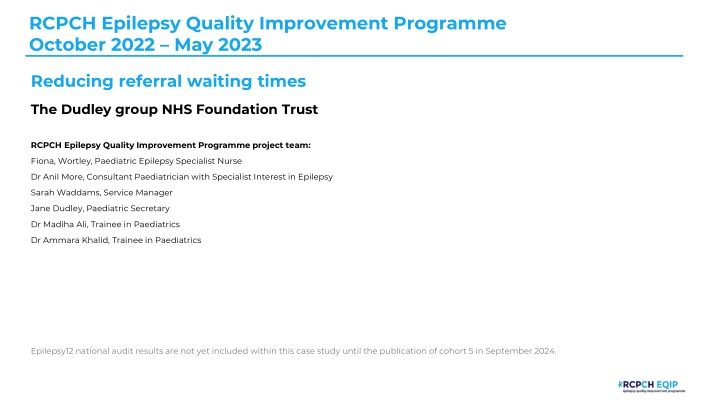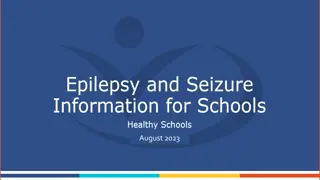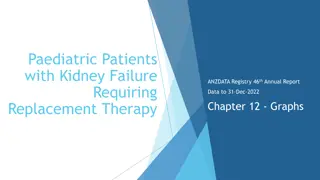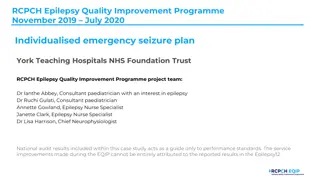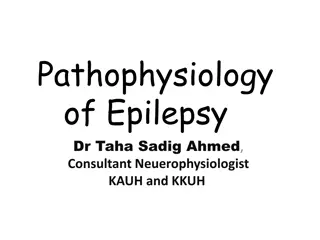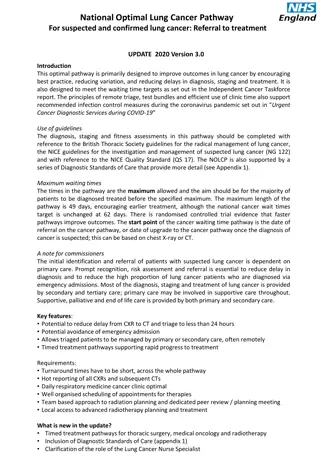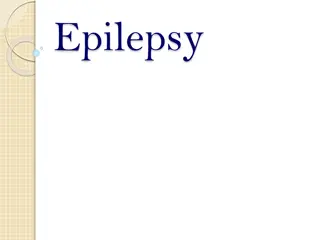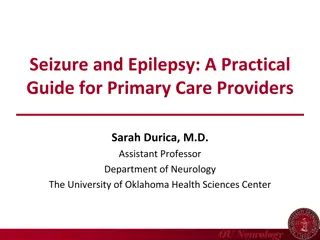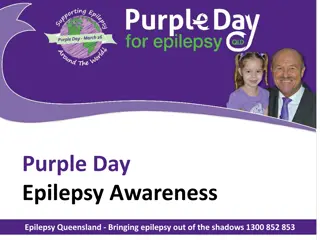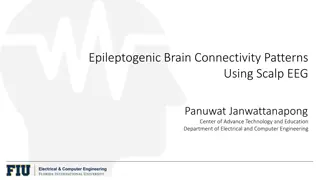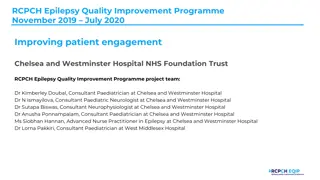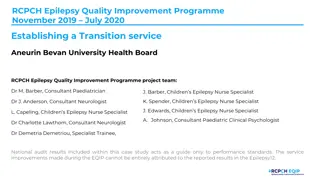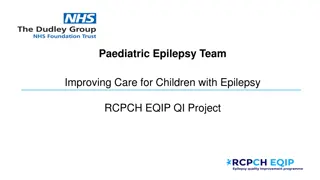Reducing Referral Waiting Times in Paediatric Epilepsy Care
The Dudley group at NHS Foundation Trust embarked on a quality improvement program to reduce patient waiting times for first appointments in the paediatric epilepsy clinic by 50%. Through initiatives like weekly patient allocation meetings, engaging with families, and enhancing staff knowledge, the team aims to streamline referral pathways and improve patient care outcomes.
Download Presentation

Please find below an Image/Link to download the presentation.
The content on the website is provided AS IS for your information and personal use only. It may not be sold, licensed, or shared on other websites without obtaining consent from the author.If you encounter any issues during the download, it is possible that the publisher has removed the file from their server.
You are allowed to download the files provided on this website for personal or commercial use, subject to the condition that they are used lawfully. All files are the property of their respective owners.
The content on the website is provided AS IS for your information and personal use only. It may not be sold, licensed, or shared on other websites without obtaining consent from the author.
E N D
Presentation Transcript
RCPCH Epilepsy Quality Improvement Programme October 2022 May 2023 Reducing referral waiting times The Dudley group NHS Foundation Trust RCPCH Epilepsy Quality Improvement Programme project team: Fiona, Wortley, Paediatric Epilepsy Specialist Nurse Dr Anil More, Consultant Paediatrician with Specialist Interest in Epilepsy Sarah Waddams, Service Manager Jane Dudley, Paediatric Secretary Dr Madiha Ali, Trainee in Paediatrics Dr Ammara Khalid, Trainee in Paediatrics Epilepsy12 national audit results are not yet included within this case study until the publication of cohort 5 in September 2024.
Reducing referral waiting times The Dudley group NHS Foundation Trust Project aim To reduce patient waiting times for first appointments in epilepsy clinic by 50% from 12 weeks to 6 weeks by May 2023. Background The paediatric epilepsy service is formed by a team of two (one consultant and one epilepsy specialist nurse), and there are currently over 215 patients with a known diagnosis of epilepsy under their care. The team went through a process of gathering data from the informatics team, which looked at consultant-led epilepsy clinics between February 2022 and January 2023 and discovered that 166 attendances for new appointments would average a waiting time of 12 weeks. NICE recommendations advise that patients who have experienced a first seizure should be seen within 2 weeks of referral. Therefore, the team felt that the guidance to achieve 2 week wait times was currently unachievable at this stage but would begin their focus on reducing wait times with a more realistic target of 6 weeks. Area of focus The team plans to map the referral pathways for new patients who are currently waiting up to 3 months for an initial appointment with the paediatric epilepsy clinics. The aim was to reduce first seizure referral waiting times by developing a first seizure clinic with a consultant and an epilepsy nurse, and to increase their knowledge and skills to help mitigate the cause of huge anxiety for children and young people and their families by providing clear advice, support, and appropriate plans for investigations and treatment.
Reducing referral waiting times The Dudley group NHS Foundation Trust
Reducing referral waiting times The Dudley group NHS Foundation Trust
Reducing referral waiting times The Dudley group NHS Foundation Trust Changes Initiated team weekly or fortnightly patient allocation meetings to discuss all new referrals and triage processes. Engaged with patients and families to better understand their needs whilst waiting for their appointment, e.g., seizure diary and videos or referral for EEG whilst waiting. Increased ESN knowledge of the ERS referral system, including how patients are screened and new referrals triaged. Reviewed Epilepsy12 audit Trust-level results on patients entered into the audit and the breakdown of their patient referral wait times between 2 and 16 weeks. The team mapped the patient pathway and liaised with secretaries to help feed into uncovering bottlenecks within the process. Patients and their families were seen for the first appointment, and those attending follow-up appointments were also involved in the process. The team trialled consultant- and nurse-led clinics. The aim is to first trial one clinic with the changes to see how it works and how it will benefit the patients. If successful, then these clinics will be set up on a more regular basis, including joint availability with both consultants and ESN.
Reducing referral waiting times The Dudley group NHS Foundation Trust
Reducing referral waiting times The Dudley group NHS Foundation Trust Results Patients are referred to their service from the GP, the inpatient paediatric ward, and from consultant colleagues in the emergency department. Planned interventions involved mapping the patient referral journey and identifying bottlenecks or unknown barriers. The team discovered that most patients are referred by the GP, then the inpatient ward, and thirdly, from the emergency department. Additionally, the team uncovered that patients who are referred from the GP are waiting longer compared to patients who are booked from the ward and are seen a lot sooner, but it was unclear how this is achieved. Patients that were referred by the GP receive a referral letter that is uploaded to the Trust s triage system. However, the triage process is quite new, where new patient appointments are added to slots within existing clinics. The new set-up will allow the care team to see patients from the beginning of their journey; however, the process requires additional physical space, which has created some difficulties. The team considered improving their GP referral pathway by educating the GPs regarding non-epileptic disorders. For various reasons, ideally, non-epileptic attack disorders should not automatically be offered a referral to the paediatric epilepsy service but rather to a pre-clinic by consultant colleagues and junior doctors who can be trained on the management of non-epileptic attack disorders. The team sees eight new patients every week and collects data from patients and their families on how long they have been waiting to be seen. The team tried a number of ways to engage patients and families via face-to-face clinics and telephone clinics. The questions asked were kept simple, giving them time to reflect on their experience when they were waiting for their initial appointment: How long did you wait from being referred to your first consultant appointment? o Did you feel the wait was too long? Too short, or just right? o Is there anything that you feel would have helped you while you were waiting for your initial appointment? o
Reducing referral waiting times The Dudley group NHS Foundation Trust Results The results found a patient waiting up to 18 weeks for an appointment. Some of the reasons for the long wait times experienced were appointments being missed or clinics being cancelled for various reasons. Feedback received from patients and families reported the following: Most families felt the waiting time was far too long. o They felt very anxious during the wait and felt they would have benefited from more information on what to do while waiting for an o appointment, such as safety advice, first aid, etc. Most patients and families feel concerned about what is going to happen to their child. Some were afraid their child could die while o having a fit. What should I do the next time a seizure happens, or is it going to happen again? Should they send their child to school? o As a result of engagement with patients, the team updated their processes by sending the RCPCH first seizure leaflets and information on first aid and safety advice with the appointment letters to help ease their worries and anxieties. Patients and families feedback on the leaflet was: The information contained in the RCPCH leaflet helped them understand what they should do prior to the appointment. o They hadn t considered some of the safety advice regarding baths. o A young person said they were able to show her friends the leaflet so they could see what they would need to do to help. o
Reducing referral waiting times The Dudley group NHS Foundation Trust
Reducing referral waiting times The Dudley group NHS Foundation Trust Challenges When new first seizure referrals are received by the Trust appointment booking office, the team discovers they are coded under neurology referrals, making it difficult to confirm the exact number of patient referrals that should be submitted to the paediatric epilepsy service team. It is unclear how referrals are booked in through the EPR system or how long they are kept on the portal before they are actioned. The team trialled several ideas, such as creating a first seizure clinic with the clinic coordinator, but discovered difficulties with finding an available clinic room, and creating slots for new referrals required additional clinic time to make more of an impact. Service managers were approached to create more clinic slots to increase the clinic capacity, which has not yet been implemented. The team experienced challenges at times with progressing their project due to clinical commitments, staff illness, engagement, and motivation after the festive period. The 1:1 monthly support meetings were helpful to begin progress. After trying to engage with the Trust quality improvement department to obtain support for the project, the team did not receive a response. The team requested help from the clinic coordinator to recode the referrals to the "Epilepsy clinic, but due to the lead consultant also running neuro-disability FUP clinics, at this stage, splitting the clinics would lead to longer waiting times. The team's greatest concern were the patients that were required to be seen sooner in hot clinics, which are run by general paediatricians. Although the team did not achieve their project goal of reducing waiting times to 6 weeks, they did reduce waiting times to 9 weeks. Recruitment is ongoing to fill a vacant post for a consultant.
Reducing referral waiting times The Dudley group NHS Foundation Trust Outcomes Although the project aim was not achieved in terms of a reduction in wait time of 6 weeks, the team still achieved the significant milestone of reducing wait time from an average of 12 to 9 weeks. The team acknowledged their increased confidence with their newly found skills, which changed their way of thinking. It was impossible to improve their service without resources from management or by employing more consultants. They recognised what can be achieved with what they already have to improve the service, taking small steps at a time, one patient at a time, one family at a time. During the course of the EQIP, the team came to understand that improvement interventions are achievable during work time, which has been a significant lesson learned. Engagement with patients and families has increased. Patient engagement was pivotal in helping to identify worries and anxieties experienced by children and young people and their families while waiting for appointments, resulting in a change of process where they are now provided with more safety net advice. Patients feel more prepared to provide seizure diaries and videos of any seizures that have happened while they have been waiting, leading to an earlier diagnosis. The team has experienced increased teamwork to improve the patient experience. Locum consultants are now doing more weekly clinics, which will help reduce waiting times further. ESN has gained knowledge and training in the process of triaging referrals, which led to a change in the process by sending new patients the RCPCH first seizure leaflets and first aid management leaflets with their appointment letter.
Reducing referral waiting times The Dudley group NHS Foundation Trust Lessons learnt Patient engagement is happening even when we are sitting and talking to families as we learn of their concerns during clinic appointments. Even small changes can make improvements. Improvement can be achieved within routine working hours. Patient and family engagement is pivotal in understanding their needs. Once you have achieved the desired outcomes of your chosen pathway, begin to apply the same improvement methods to other pathways beyond the programme. When engaging with patients and families, keep your questions short and simple, which also makes it easier to record and respond to the results. Regular referral screening as a team helped to understand the pathway and ensure correct allocation into the most appropriate clinic. By doing this more frequently, it prevents bottlenecks, therefore reducing delays in appointment allocation. During the referral screening stage, health information can be sent to the appropriate patients while they wait to be seen in the clinic. Focus on what can be done instead of focusing on what cannot be done or what is out of your control.
https://eqip.rcpch.ac.uk eqip@rcpch.ac.uk @RCPCHEQIP
